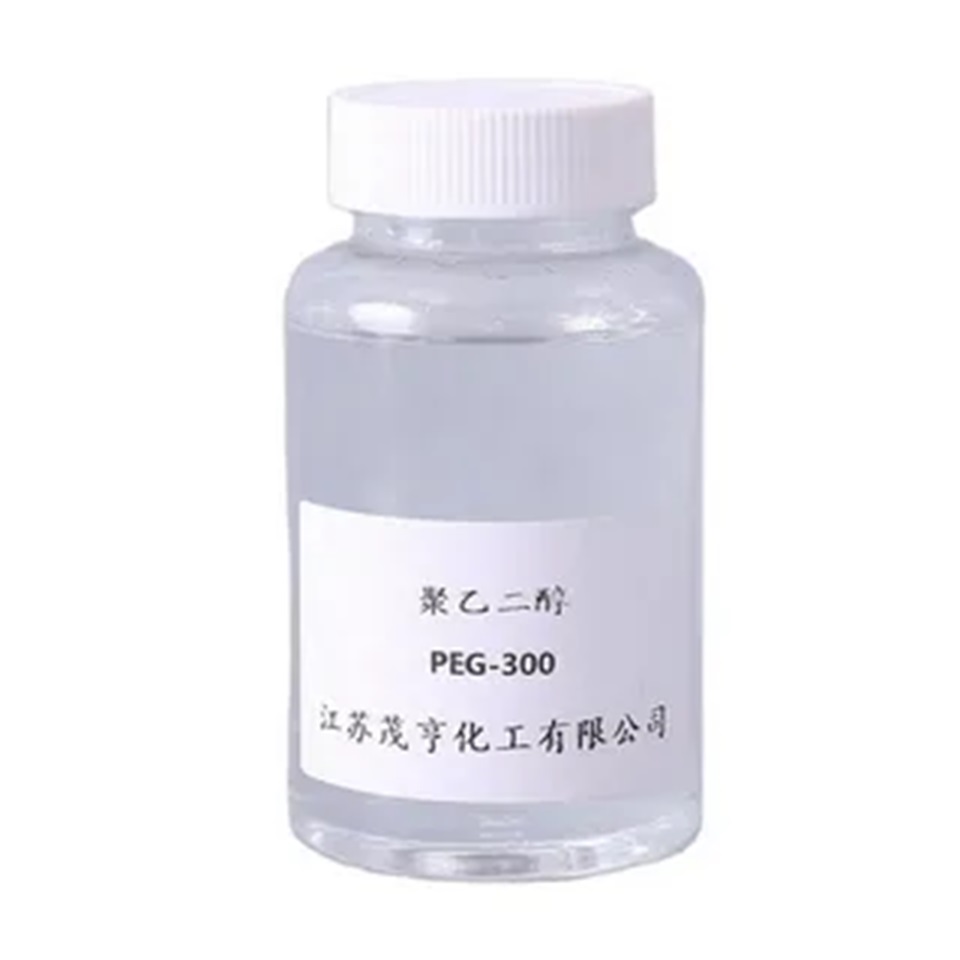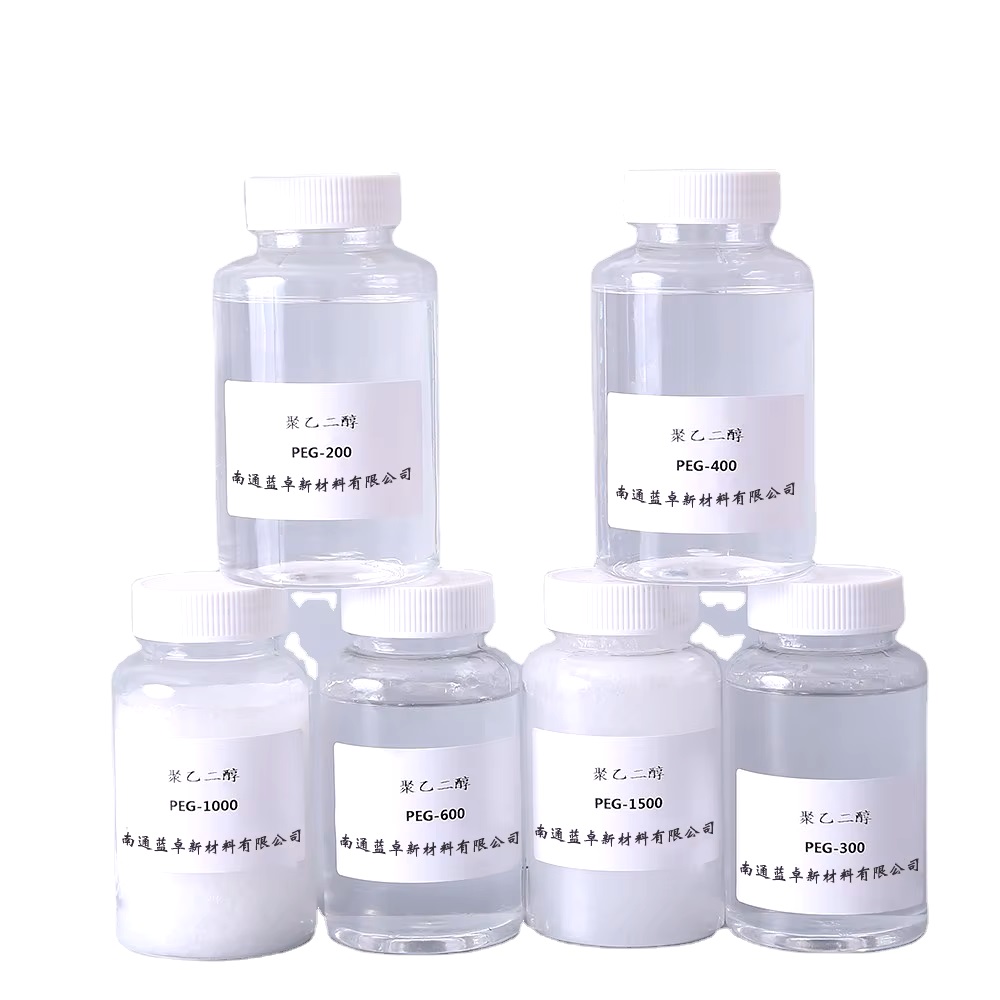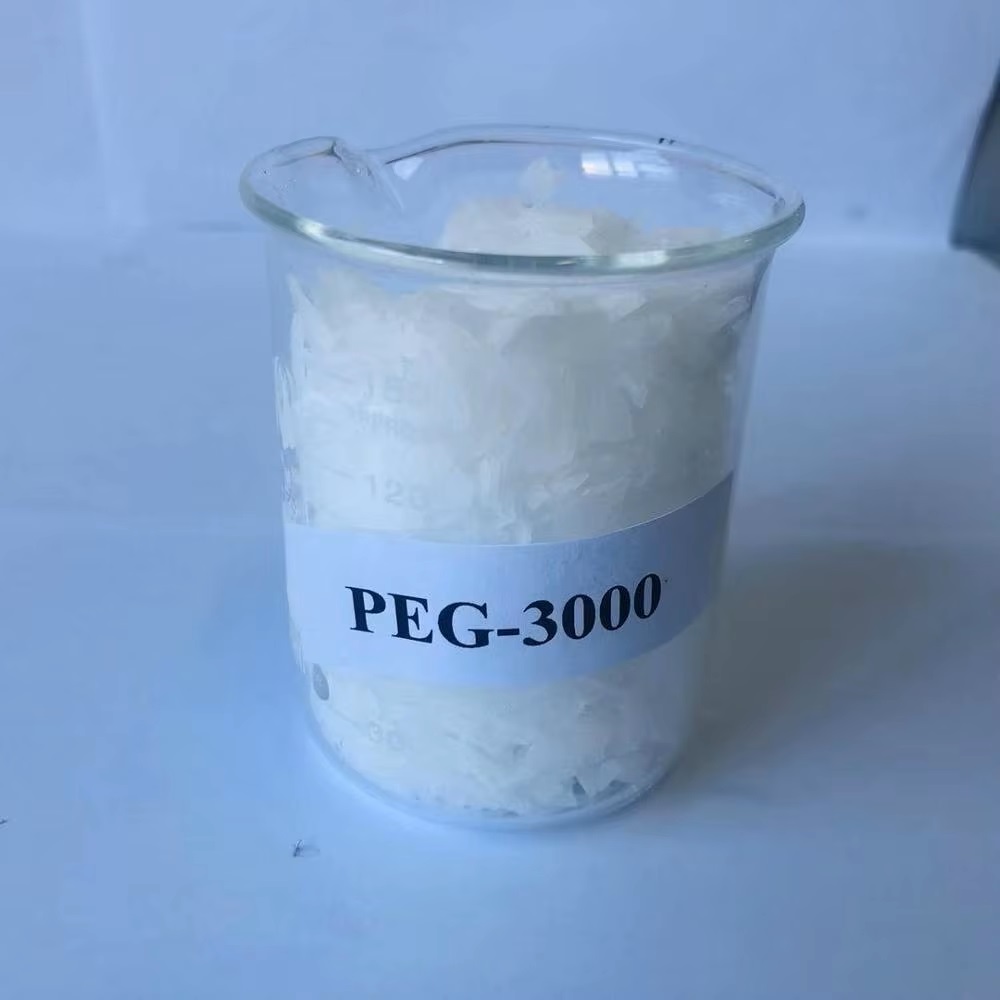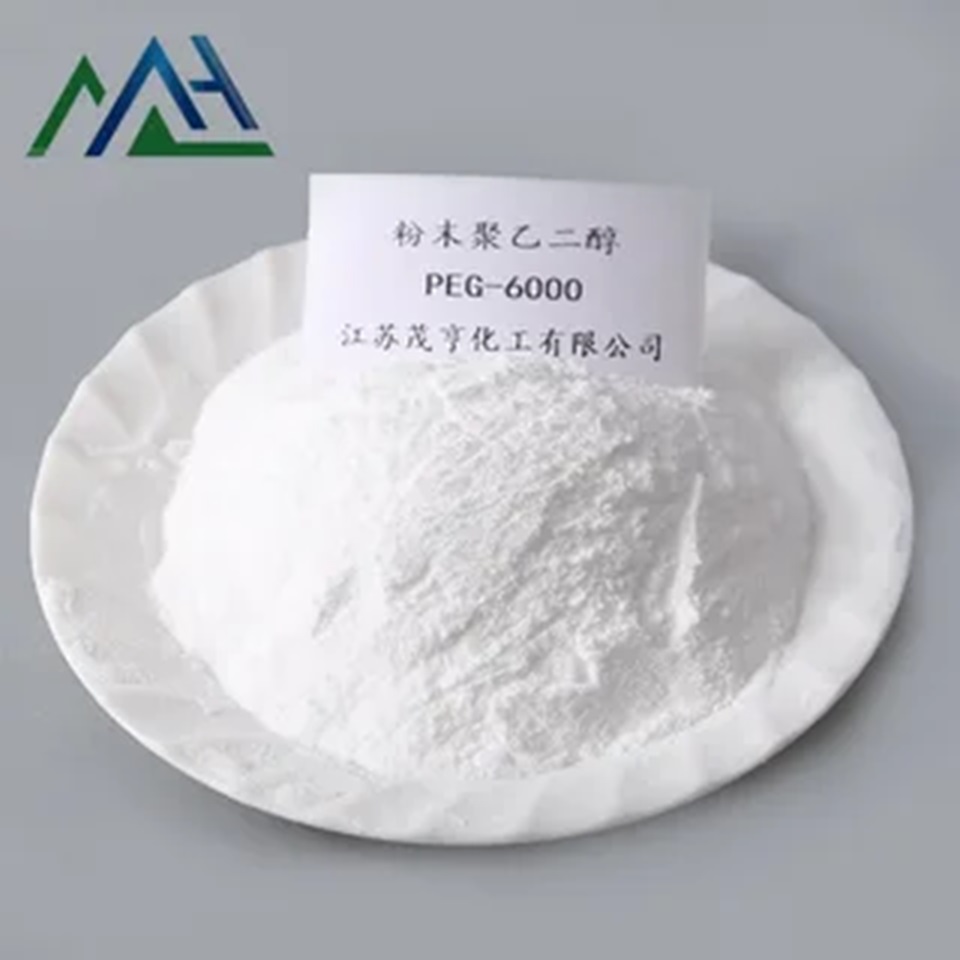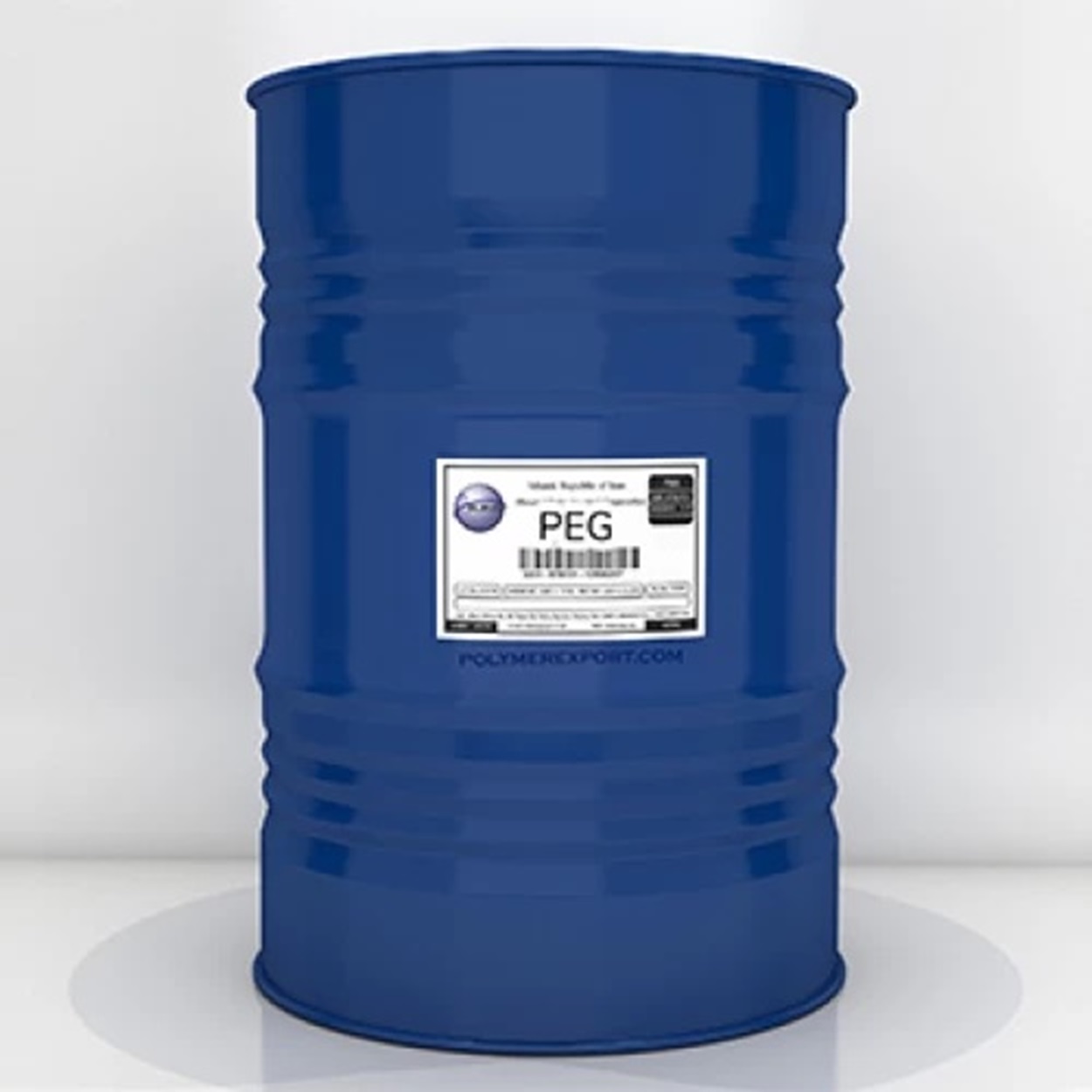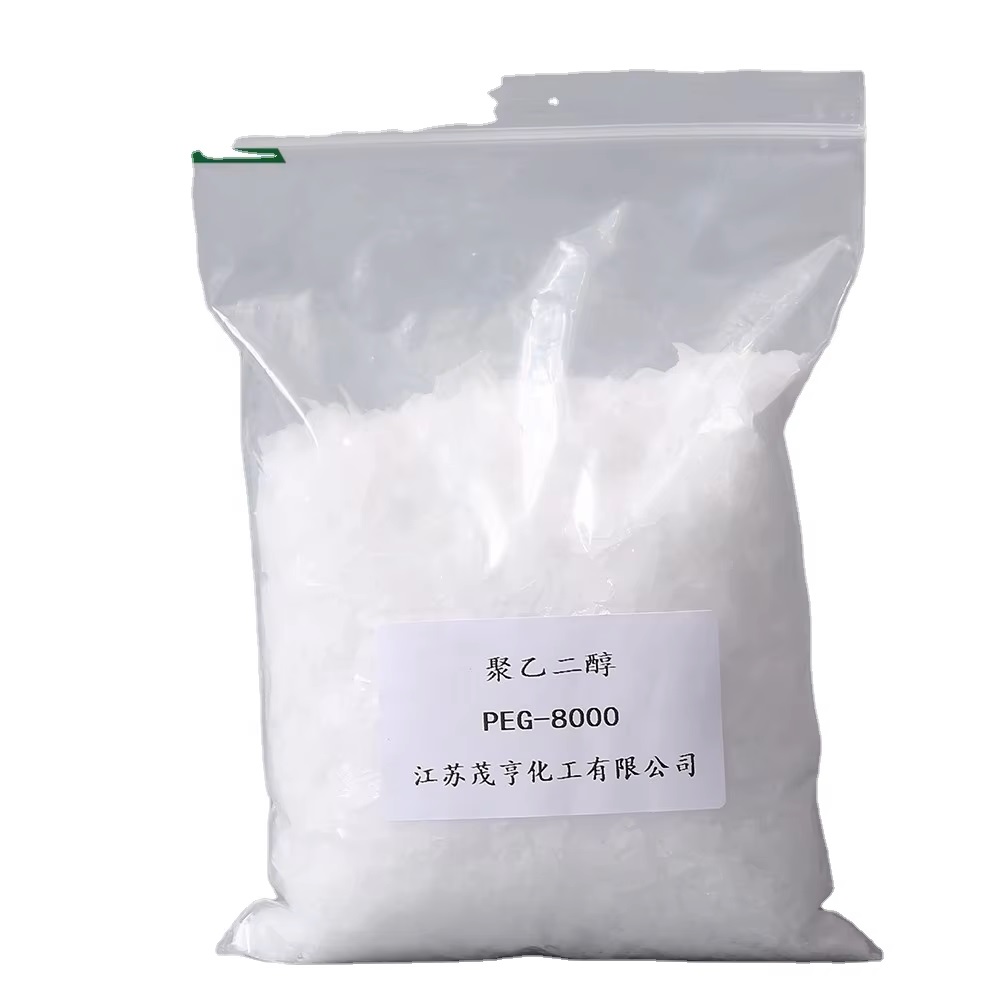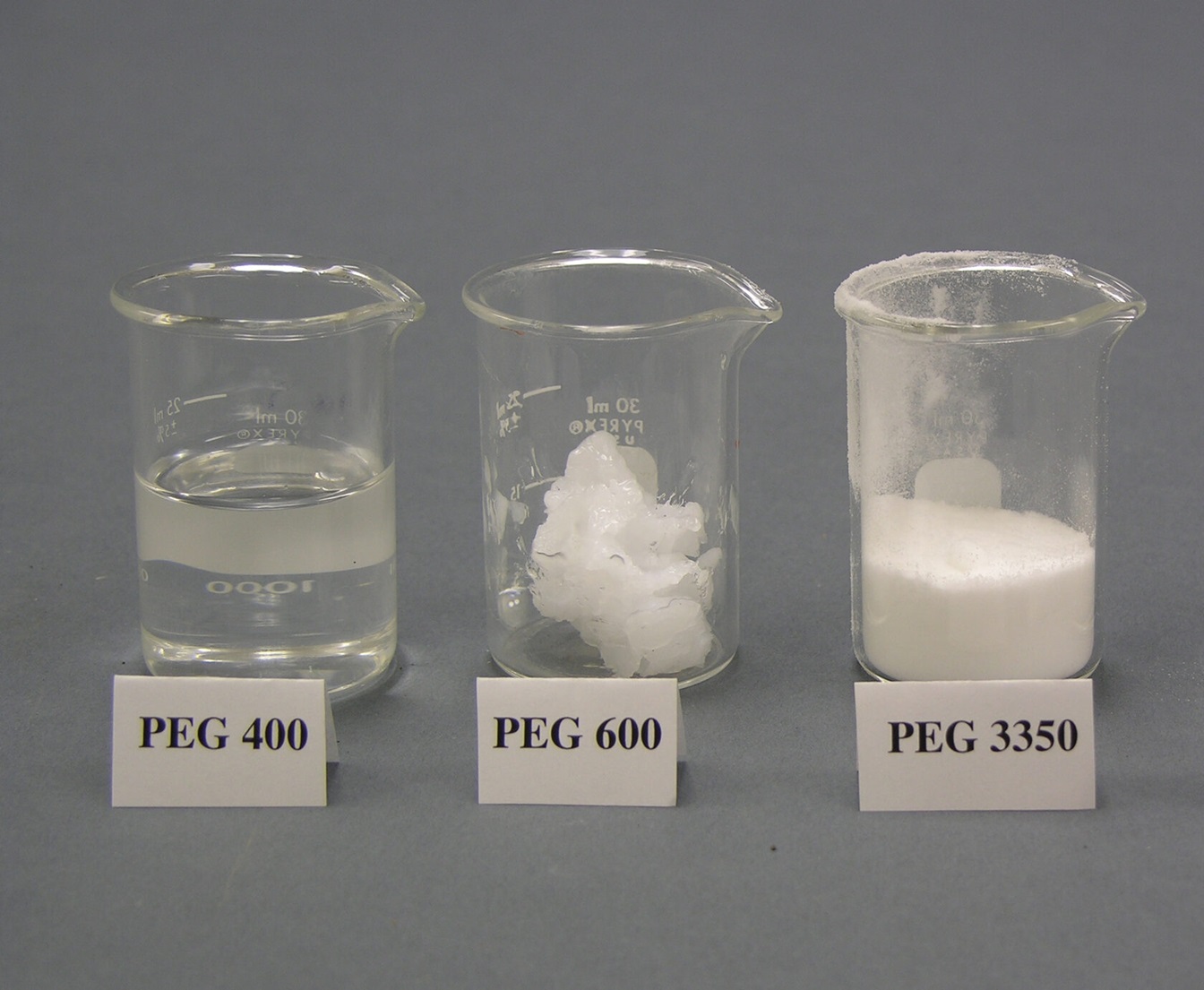We unleash your business potential by maximize the business innovation.
Send EmailPolyethylene Glycol, PEG, PEG200, PEG300, PEG400, PEG600, PEG1000, PEG1500, PEG4000, PEG6000, PEG8000, PEG10000, 25322-68-3
BASF PRODUCTS:
- Pluriol® E 200 Polyethylene glycol 200 Liquid approx. 100 approx. 60–560
- Pluriol® E 300 300 Liquid approx. 100 approx. 85––
- Pluriol® E 400 400 Liquid approx. 100 approx. 110–260
- Pluriol® E 600 600 Liquid/Solid approx. 100 approx. 40 (50 °C) approx. 20 190
- Pluriol® E 600 S 600 Liquid approx. 100 approx. 40 (50 °C)–190
- Pluriol® E 1500 E 1500 Solid approx. 100 approx. 60 (75 °C) approx. 45 75
- Pluriol® E 1500 Flakes 1500 Flakes approx. 100 approx. 60 (75 °C) approx. 45
- Pluriol® E 3400 Flakes 3400 Flakes approx. 100 approx. 190 (75 °C) approx. 55 33
- Pluriol® E 4000 Flakes 4000 Flakes approx. 100 approx. 260 (75 °C) approx. 55 28
- Pluriol® E 4000 Powder EcoBalanced 4000 Flakes approx. 100 approx. 120 (99 °C) approx. 55 28
- Pluriol® E 4000 Powder 4000 Flakes approx. 100 approx. 120 (99 °C) approx. 55 28
- Pluriol® E 6000 Flakes 6000 Flakes approx. 100 approx. 600 (75 °C) approx. 60 19
- Pluriol® E 8000 Flakes 8000 Flakes approx. 100 approx. 130* (50 °C) approx. 63 13
- Pluriol® E 8000 E 8000 Solid approx. 100 approx. 800 (99 °C) approx. 64 13
- Pluriol® E 9000 Powder 9000 Powder approx. 100 approx. 260* (50 °C) approx. 65
- Pluriol® E 10000 10 000 Solid approx. 100 approx. 1300 (99 °C) approx. 65 11
🧪 Polyethylene Glycol (PEG) – Technical Specifications
| Property | Description |
|---|---|
| Chemical Name | Polyethylene Glycol (PEG) |
| CAS Number | 25322-68-3 (general for PEG series) |
| Chemical Formula | HO–(CH₂CH₂O)ₙ–H |
| Physical Form | Liquid, semi-solid, or solid (depends on MW) |
| Solubility | Fully soluble in water and many organic solvents |
| pH (1% solution) | ~5.0–7.0 (neutral) |
| Toxicity | Low; FDA-approved, biocompatible |
🔬 PEG Grades & Molecular Weight Versions
| PEG Grade | Approx. MW | Physical Form | Typical Use Cases |
|---|---|---|---|
| PEG 200–600 | Low MW | Clear viscous liquid | Cosmetics, textiles, rubber, pharmaceuticals |
| PEG 1000–2000 | Medium MW | Semi-solid gel | Food additives, pharma carriers |
| PEG 3000–6000 | High MW | White powder or flakes | Tablet binders, plastic additives |
| PEG 8000+ | Very high MW | Solid | Hydrogels, controlled-release systems |
⚙️ Functional Applications by Sector
| Sector | Function / Application |
|---|---|
| Cosmetics | Humectant, carrier, viscosity modifier |
| Pharmaceuticals | Tablet binder, injectable carrier, PEGylation agent |
| Food | Emulsifier, coating agent, carrier (E1521) |
| Textile | Softener, moisture retainer, process aid |
| Plastics/Rubber | Mold release agent, antistatic additive |
| Biomedical | Hydrogel matrix, nanoparticle coating, drug delivery |
🔍 Alias-Free Naming Variants
| Name Variant | Notes |
|---|---|
| Polyethylene Glycol (PEG) | Standard technical name |
| Macrogol | INCI/pharmaceutical name |
| Carbowax | Trade name (Dow, Union Carbide) |
| Polyglykol / Polietilen Glikol | Turkish equivalents |
| E1521 | Food additive code |
| PEGylated / PEGylation | Refers to PEG-modified molecules |
PEG 200, 300, 400, 600, 800, 900, 1000, 1500, 4000, 6000, 8000, 10000 -->CAS: 25322-68-3
Molecular Formula: N/A PEG 300,400,600,1000,1500,4000,6000,8000
Names and Identifiers
| Name | Poly(ethylene glycol) |
| Synonyms | PEO PEG PEG 600 PEG 200 PEG 400 macrogol carbowax PEG 6000 PEG 8000 PEG 1000 Carmowax alcoxe30 Alcox E 30 Alcox E 160 Aquacide III PEG 200-8000 poly(oxyethylene) Polyethyleneglycol Polyethylene glycol PolyethyleneoxideMW Polyethylene Glycol Polyethylene glygcol Poly(ethylene oxide) Poly ethylene glycol Poly(ethylene glycol) Polyethylene glycol PEG Polyethylene glycol series 1,2-ethanediol,homopolymer Polyethylene Glycol 5000000 PEG 6000, MB Grade (1.12033) Ethylene glycol 8000 polymer Polyethylene glycol - 6000 grade Tri-(2,3-Dibromopropyl) Phosphate polyethylene oxide standard 511000 Poly(ethylene oxide),approx. M.W. 200,000 Poly(ethylene oxide),approx. M.W. 900,000 Poly(ethylene oxide),approx. M.W. 600,000 O-Methacryloxy(polyethyleneoxy)trimethylsilane 2-ethanediyl),.alpha.-hydro-.omega.-hydroxy-Poly(oxy-1 Polyethyleneoxidemonomethacryloxymonotrimethylsiloxyterminated |
| CAS | 25322-68-3 |
| EINECS | 500-038-2 |
Physico-chemical Properties
| Molecular Formula | N/A |
| Density | 1.27g/mLat 25°C |
| Melting Point | 64-66°C |
| Boling Point | >250°C |
| Flash Point | 270 °C |
| Water Solubility | Soluble in water. |
| Solubility | Slightly hygroscopic. It melts easily when heated. Soluble in water and ethanol |
| Vapor Presure | <0.01 mm Hg ( 20 °C) |
| Vapor Density | >1 (vs air) |
| Appearance | waxy solid |
| Specific Gravity | 1.128 |
| Color | White to very pale yellow |
| Maximum wavelength(λmax) | ['λ: 260 nm Amax: 0.6', , 'λ: 280 nm Amax: 0.3'] |
| Merck | 14,7568 |
| PH | 5.5-7.0 (25℃, 50mg/mL in H2O) |
| Storage Condition | 2-8°C |
| Stability | Stable. Incompatible with strong oxidizing agents. |
| Sensitive | Hygroscopic |
| Refractive Index | n20/D 1.469 |
| MDL | MFCD00081839 |
| Physical and Chemical Properties | Density 1.125 melting point -65°C refractive index 1.458-1.461 flash point 171°C |
| Use | Used as PVC lubricant, masterbatch additive, textile softener, pigment dispersant, etc |
Risk and Safety
| Risk Codes | R36/38 - Irritating to eyes and skin. R52/53 - Harmful to aquatic organisms, may cause long-term adverse effects in the aquatic environment. R33 - Danger of cumulative effects R23/24/25 - Toxic by inhalation, in contact with skin and if swallowed. |
| Safety Description | S26 - In case of contact with eyes, rinse immediately with plenty of water and seek medical advice. S36 - Wear suitable protective clothing. S24/25 - Avoid contact with skin and eyes. S61 - Avoid release to the environment. Refer to special instructions / safety data sheets. S45 - In case of accident or if you feel unwell, seek medical advice immediately (show the label whenever possible.) S36/37 - Wear suitable protective clothing and gloves. |
| WGK Germany | 3 |
| RTECS | TQ4110000 |
| FLUKA BRAND F CODES | 3-9 |
| TSCA | Yes |
| HS Code | 39072011 |
| Hazard Note | Harmful |
| Toxicity | LD50 orally in Rabbit: 28000 mg/kg LD50 dermal Rabbit > 20000 mg/kg |
Upstream Downstream Industry
| Raw Materials | Poly(ethylene) Ethylene Oxide Hexane |
Nature
This product is white granular. Soluble in water, soluble in some organic solvents. The solution has high viscosity at low concentration, and can be processed by calendering, extrusion, casting, etc. It is a thermoplastic resin with good compatibility with other resins. Resistant to bacterial erosion, moisture absorption in the atmosphere is weak.
Preparation Method
ethylene oxide was self-polymerized under the catalysis of aluminum isopropoxide.
Standard
This product is a mixture of ethylene oxide and water polycondensation. The molecular formula is expressed as ho(ch2ch2o)nh, where n represents the average number of oxyethylene groups.
Trait
- This product is a colorless or almost colorless viscous liquid, or a translucent waxy soft object; Slightly odorless.
- This product is soluble in water or ethanol, insoluble in ether.
freezing point
The freezing point of this product (General rule 0613) is 33~38°C.
viscosity
take 25.0g of this product, put it in a 50ml measuring flask, add water to dissolve it and dilute it to the scale, shake it well, and use a pinch viscometer with a capillary inner diameter of 0.8mm, the kinematic viscosity at 0633 is 401 to 8.5/s when measured according to law (General Principles 11.0, first method).
Introduction
Gas chromatography stationary solution (maximum service temperature 200 ℃, solvent acetone, chloroform, dichloromethane), separation and analysis of alcohols, ketones, aldehydes and other oxygenates.
Differential diagnosis
- take 10% g of this product, add 5ml of dilute hydrochloric acid and 1 ml of barium chloride solution, shake and filter; Add 1 ml of phosphomolybdic acid solution to the filtrate to produce yellow-green precipitate.
- take 0.lg of this product, put it in a test tube, add 0.lg of potassium thiocyanate and 0.lg of cobalt nitrate, mix it, add 5ml of methylene chloride, and the solution is blue.
Use
poly (ethylene oxide) resins are high molecular weight homopolymers of ethylene oxide via heterogeneously catalyzed ring-opening polymerization. Usually can be divided into the relative molecular mass of 2 × 1 04 above and tens of thousands of above, the former is called polyethylene glycol, the latter is called polyethylene oxide. Polyethylene oxide with flocculation, thickening, slow release, lubrication, dispersion, retention, water retention and other properties, suitable for medicine, fertilizer, paper, ceramics, detergents, cosmetics, heat treatment, water treatment, fire, oil exploitation and other industries, the product is non-toxic and non-irritating, and will not remain, deposit or breed volatile matter in the process of product generation. As a papermaking additive, the retention rate of the filler and the fine fiber can be improved, and the dispersant is particularly suitable for the long fiber, and the beating time can be shortened.
Safety
The skin, eye irritation is very small, oral is difficult to be absorbed by the gastrointestinal tract, low toxicity. Injection of an aqueous solution of 5% by mass of polyethylene oxide into the eyes of rabbits caused only mild burning. Polyethylene oxide had little effect on the death rate of fish, crab, sea anemone, shrimp or algae. Its resin and aqueous solution are low toxicity, use and handling are very safe. The US Food and Drug Administration (FDA) has approved polyethylene oxide aqueous solution resins for use as direct additives for specialty food packaging and beer.
Exam
average molecular weight
take this product about 3.0G, precision weighing, dry 250ml plug Erlenmeyer flask, precision plus phthalic anhydride pyridine solution (take phthalic anhydride 14g, dissolve in anhydrous pyridine 100ml, place overnight, (Ready use) 25ml, shake well, add a small amount of anhydrous pyridine to the edge of the mouth of the conical flask, place it in a boiling water bath, heat it for 30-60 minutes, take it out for cooling, and add sodium hydroxide titration solution (0.5mol/L) accurately. 50ml, with phenol pyridine solution (1-100) as an indicator, with sodium hydroxide titration solution (0.5mol/L) titration to red, and the results of the titration with blank test correction. The product of the test quantity (g) and 4000, divided by the volume (ml) of the consumed sodium hydroxide titration solution (0.5mol/L), that is, the average molecular weight of the sample, should be 900 to 1100.
acidity
take l.Og of this product, add water to dissolve 20ml, and then determine it according to law (General rule 0631). The pH value should be 4.0~7.0.
clarity and color of solution
Take 5.0g of this product, add 50ml of water to dissolve, check according to law (General rule 0901 and general rule 0902), the solution should be clear and colorless; If it is turbid, it should not be more concentrated compared with No. 2 Turbidity standard solution (General rule 0902 first method); If it is colored, it should not be deeper compared with yellow No. 2 Standard Colorimetric solution (General rule 0901 first method).
ethylene glycol, diethylene glycol and triethylene glycol from ethylene glycol, diethylene glycol and triethylene glycol
Each 400mg of the control was placed in a 100ml measuring flask, diluted to the scale with absolute ethanol, and shaken to serve as a control stock solution. Take the internal standard substance 1, 3-butanediol 400mg, put it in a 100ml measuring flask, dilute it to the scale with absolute ethanol, shake it well, and use it as an internal standard stock solution, take 1.0ml of the control stock solution and 4.0 ml of the internal standard stock solution, put them in a measuring flask, dilute them to the scale with absolute ethanol, shake them well, and use them as the control solution, add 1.0ml of human internal standard stock solution to a 100ml measuring flask, dilute to the scale with absolute ethanol, and shake to form a test solution. The above solution was taken and silicone was used as the stationary phase. The initial temperature was 600°C, maintained for 5 minutes, ramped up to 170°C at a rate of 2°C per minute, maintained for 5 minutes, and then ramped up to 280°C at a rate of 15°C per minute for 50 minutes. The inlet temperature was 270°C and the detector temperature was 290°C. The carrier gas is high purity N2. The gas is H2. The auxiliary gas is compressed air. The column flow was 4.0 ml/min. Calculated according to internal standard method, containing ethylene glycol, diethylene glycol and triethylene glycol shall not exceed 0.1%.
ethylene oxide and dioxane
take this product lg, precision weighing, top empty bottle, Precision Plus 1.0 pure water, sealed, shake, as a test solution. Measure 30ul of ethylene oxide (equivalent to 0.25g ethylene oxide) into a 400 volumetric flask containing 50ml of treated polyethylene glycol 1.5 (rotary evaporation at 60°C, to 2.5kPa for 6 hours to remove volatiles), add the same solvent to dilute to the scale, shake well, as the stock solution of ethylene oxide reference, weigh the stock solution of 1g cold ethylene oxide reference, in a 50ml measuring flask containing 40ml of treated polyethylene glycol 400, dilute to the mark with the same solvent. Weigh 10G, put it in a 50ml measuring flask containing 30ml of water, and dilute it with water to the mark. Take 10 m l for precision measurement, put it in 50ml measuring flask, dilute it to the scale with water, shake it well, and use it as the reference solution of ethylene oxide. The appropriate amount of dioxane was accurately determined, and a solution containing 0.1 mg per 1ml of water was prepared as a dioxane control solution. Weigh lg of this product accurately, place it in the top empty bottle, add 0.5m ethylene oxide reference solution and 0.5ml dioxane reference solution, seal and shake, and use as the reference solution. Take 0.001% ml of ethylene oxide control solution in the top empty bottle and add the freshly prepared acetaldehyde solution 0.1ml and 0.1ml of the two testis six ring control solution, sealed, shake, as the system suitability test solution, according to the gas chromatography (General 0521) test, with polydimethylsiloxane as the fixing liquid, starting at 35°C for 5 minutes, ramping up to 180°C at a rate of 5°C per minute, then ramping up to 230°C at a rate of 30°C per minute, maintain 5 minutes (can be adjusted according to the specific situation). The inlet temperature was 150°C, the detector temperature was 250°C, the headspace bottle equilibrium temperature was 70°C, and the equilibrium time was 45 minutes. Take the system suitability test solution for Headspace sampling, adjust the detector sensitivity so that the peak height of ethylene oxide peak and acetaldehyde peak is about 15% of the full scale, and the separation degree between acetaldehyde peak and ethylene oxide peak is not less than 2.0, the peak height of dioxane should be more than 5 times of the baseline noise, and the test solution and the reference solution should be respectively injected in the headspace, and the sample should be repeated for at least 3 times.
of the peak area of ethylene oxide The relative standard deviation shall not exceed 15%, and the relative standard deviation of the peak area of dioxane shall not exceed 10%. According to the standard plus person method, ethylene oxide shall not exceed 0.0001% and dioxane shall not exceed 0.001%.
formaldehyde
take this product lg, precision weighing, add 0.0.25ml of 6% sodium chromotropic solution, after cooling in ice water, add 5ml of sulfuric acid, shake well, stand for 15 minutes, slowly and quantitatively transfer to a 25ml measuring flask containing 10ml of water, and let it cool, slowly add water to the scale, shake, as a test solution. In addition, 0.81g of formaldehyde was weighed accurately, placed in a 100ml measuring flask, diluted to the scale with water, and then lml was weighed accurately, placed in a 100ml measuring flask, diluted to the scale with water; Then, lml was weighed accurately, from "join 0. Starting from 0.25ml of 6% sodium chromotropic solution, the same method was used as the control solution. The above two solutions were taken and the absorbance was measured at a wavelength of 0401 nm by UV-Vis spectrophotometry (general), and corrected with the blank solution operated in the same way. The absorbance of the test solution shall not be greater than that of the control solution (0.003%).
moisture
take 2.0g of this product, according to the determination method of moisture (General rule 0832 first method 1), the water content shall not exceed 1 .0%.
burning residue
not more than 0.1% (General rule 0841).
Heavy metals
take 4.0g of this product, add 5ml of hydrochloric acid solution (9-1000) and an appropriate amount of water, dissolve it, adjust the pH value to 3.0~4.0 with dilute acetic acid or ammonia test solution, and dilute it to 25ml with water, inspection according to law (General Principles 0821, law I), containing heavy metals shall not exceed 5 parts per million.
Category
pharmaceutical excipients, soft matrix and lubricants.
Storage
sealed storage.
Reference Information
| LogP | -0.698 at 25℃ |
| polymer compound | polyethylene glycol is abbreviated as "PEG". A polymer compound formed by intermolecular dehydration and condensation of ethylene glycol. Chemical formula HOCH2(CH2OCH2)nCH2OH. where n is greater than 4. The average molecular weight is 200~7000. The number after commodity polyethylene glycol indicates the average molecular weight. For example, polyethylene glycol -400 means that the average molecular weight of the commodity polyethylene glycol is about 400. colorless viscous liquid or white solid. Low toxicity! Soluble in water and many organic solvents, easily soluble in aromatic hydrocarbons, slightly soluble in aliphatic hydrocarbons. It does not hydrolyze for a long time, is stable to heat, and does not react with many chemical reagents. Some metal salts are soluble in polyethylene glycol at about 100 ℃ and remain stable at room temperature. These metal salts include calcium, cobalt, copper, iron, magnesium, manganese, tin and zinc chlorides, potassium iodide and ethyl mercury. It can be used as plasticizer, softener, wetting agent, lubricant, solvent, binder, and can also be used as perfume and pharmaceutical preparation. |
| Chemical properties | Different properties vary according to the relative molecular mass, from colorless and odorless viscous liquid to waxy solid. Those with a molecular weight of 200~600 are liquid at room temperature, and those with a molecular weight of more than 600 gradually become semi-solid. With the difference of average molecular weight, the properties are also different. From colorless, odorless, viscous liquids to waxy solids. As the molecular weight increases, its moisture absorption capacity decreases accordingly. This product is soluble in water, ethanol and many other organic solvents. The vapor pressure is low and stable to heat, acid and alkali. It doesn't work with many chemicals. It has good moisture absorption, lubricity and adhesion. Non-toxic, non-irritating. The average molecular weight is 300,n = 5~5.75, melting point is -15~8 ℃, and the relative density is 1.124~1.130. The average molecular weight is 600,n = 12~13, melting point is 20~25 ℃, flash point is 246 ℃, relative density is 1.13 (20 ℃). The average molecular weight is 4000,n = 70~85, melting point is 53~56 ℃. Under normal conditions, polyethylene glycol is very stable, but it can interact with oxygen in the air at a temperature of 120°C or higher. In an inert atmosphere (such as nitrogen and carbon dioxide), it will not change even if it is heated to 200~240 ℃, and thermal cracking will occur when the temperature rises to 300 ℃. Adding antioxidants, such as phenothiazine with a mass fraction of 0.25% ~ 0.5%, can improve its chemical stability. Any of its decomposition products are volatile and do not produce hard shells or slime-like precipitates. polyethylene glycol is a polymer of ethylene oxide hydrolysate, which is non-toxic and non-irritating, and is widely used in various pharmaceutical preparations. Low molecular weight polyethylene glycol is relatively toxic. Overall, the toxicity of diols is quite low. Topical application of polyethylene glycol, especially mucosal administration, can cause irritant pain. In topical lotions, this product can increase the flexibility of the skin and has a moisturizing effect similar to glycerin. Diarrhea can occur in large doses of oral administration. In the injection, the maximum concentration of polyethylene glycol 300 is about 30%(V/V), and hemolysis can occur when the concentration is greater than 40%(V/V). |
| Melting agent | An excellent chemical melting agent for protoplast fusion. It is a polymer of ethylene glycol with the molecular formula HOCH2(CH2O · CH2)nCH2OH. It is a white yellowish waxy solid, soluble in water and has a slight odor. There are a series of polymers with different relative molecular masses. Those with relative molecular masses between 200 and 6000 can be used as melting agents, but those with 1000 are better (liquid at this time). PEG has strong water solubility. In the liquid medium, the ether bond on the surface of its molecule has a weak negative charge. With the participation of Ca2 + ions, positively charged surface proteins or negatively charged glycoproteins can be connected through Ca2 + bridges, thus causing cells to aggregate and fuse. In 50% PEG, free water disappears, which can lead to cell dehydration and cause changes in the membrane structure and cell fusion. The advantages of PEG in cell fusion are: ① It has strong versatility and can be used in various cells of organisms, plants and microorganisms. ② It is easier to prepare and control than Sendai virus. ③The activity is stable and easy to use. the disadvantage is: ① the effective concentration range is narrow (50% ~ 55%), but it is toxic to cells at this time. ② The fusion process of cells cannot be observed under the microscope. ③ The frequency of induction of hybrid cells is relatively low (about 1 × 10-5). In addition to being used as a melting agent, it can also be used to promote the uptake of exogenous transformed DNA by yeast, and can be used as a precipitant in clinical chemistry and an osmotic concentrator for aqueous solutions or suspensions such as serum. |
| Ultraviolet Absorber UV-1130 | Ultraviolet Absorber UV-1130 is a hydroxyphenylbenzotriazole type ultraviolet light absorber with a light yellow to light amber appearance. The viscous liquid is easily soluble in polar and non-polar solvents, insoluble in water, can effectively protect the gloss of the coating, avoid cracks and spots, the product is easy to emulsify, especially suitable for water-based systems, dispersion in aqueous systems can be obtained by dissolving in water-soluble solvents such as diethylene glycol diethyl ether. It has good high temperature resistance and extraction resistance, especially suitable for industrial and automotive coatings with high weather resistance requirements, and can also provide sufficient protection for sensitive substrates such as wood. commercially sold coatings are shared with hindered amine (HALS), such as light stabilizer 292 or 123. These common synergistic agents can significantly improve the coating performance and prevent it from losing light, cracking, blistering, shedding and discoloration. light stabilizer can be added to the car finish varnish or primer. However, according to our experience, adding light stabilizers to the topcoat has the best protection effect. |
| application in biomedical field | medical polyethylene glycol is also called polyethylene oxide (PEO). Linear polyether obtained by ring-opening polymerization of ethylene oxide. The main uses in the biomedical field are as follows: 1) Contact lens liquid. The viscosity of polyethylene glycol aqueous solution is sensitive to shear rate and bacteria are not easy to grow on polyethylene glycol. 2) synthetic lubricant. Condensation polymer of ethylene oxide with water. The ointment matrix for the preparation of water-soluble drugs can also be used as a solvent for insoluble water-soluble drugs such as acetylsalicylic acid and caffeine for the preparation of injections. 3) carrier of drug sustained release and immobilized enzyme. Applying polyethylene glycol aqueous solution to the outer layer of the pill can control the diffusion of the drug in the pill to improve the efficacy. 4) surface modification of medical polymer materials. The use of amphiphilic copolymers containing polyethylene glycol to adsorb, intercept and graft on the surface of medical polymer materials can improve the biocompatibility of medical polymer materials in contact with blood. 5) Making alkanol contraceptive film. 6) making hydrophilic anticoagulant polyurethane. 7) polyethylene glycol 4000 is an osmotic laxative, which can increase osmotic pressure in the intestinal cavity, absorb water, soften feces, increase volume, and promote intestinal peristalsis and defecation. 8) Denture fixative. Using polyethylene glycol non-toxic and gelling properties, it is used as a component of denture fixative. 9) PEG 4000 and PEG 6000 are often used to promote cell fusion or protoplast fusion and help organisms (such as yeast) to take DNA in transformation. PEG can absorb water in the solution, so it is also used to concentrate the solution. |
| main uses and functions | polyethylene glycol and polyethylene glycol fatty acid esters are widely used in cosmetic industry and pharmaceutical industry. Because polyethylene glycol has many excellent properties: water solubility, non-volatility, physiological inertness, mildness, lubricity and skin wetting, softness, and pleasant feeling after use. Polyethylene glycol with different relative molecular mass fractions can be selected to change the viscosity, moisture absorption and tissue structure of the product. Polyethylene glycol (Mr<2000) with low molecular weight is suitable for use as wetting agent and consistency regulator, for cream, emulsion, toothpaste, shaving cream, etc., and also for hair care products without cleaning, giving hair filamentous luster. Polyethylene glycol (Mr >2000) with high molecular weight is suitable for lipstick, deodorant stick, soap, shaving soap, foundation and beauty cosmetics. In cleaning agents, polyethylene glycol is also used as a suspending agent and thickener. In the pharmaceutical industry, it is used as a matrix for ointments, emulsions, ointments, lotions and suppositories. Commercially available polyethylene glycol (such as Polyethylene Glycol NF,Dow chemical Co.) that conforms to food and drug use is more suitable for cosmetic use. The application of methoxy polyethylene glycol and polypropylene glycol is similar to that of polyethylene glycol. polyethylene glycol is widely used in a variety of pharmaceutical preparations, such as injection, topical preparations, ophthalmic preparations, oral and rectal preparations. Solid-grade polyethylene glycol can be added with liquid polyethylene glycol to adjust the viscosity for topical ointment; polyethylene glycol mixture can be used as suppository matrix; polyethylene glycol aqueous solution can be used as a suspending agent or used to adjust the viscosity of other suspension media; polyethylene glycol and other emulsifiers are combined to increase the stability of the emulsion. In addition, polyethylene glycol is also used as film coating agent, tablet lubricant, controlled release material, etc. |
| safety | the food additive supplement regulations of the U.S. federal food, drug and cosmetic regulations have approved the direct or indirect use of food chemical pharmacopoeia grade polyethylene glycol as a food additive. FAO/WHO1985 year stipulates ADI value as 0~10 mg/kg body weight. GRAS(FDA,§ 172.820,1985). Acute oral toxicity (mouse) LD5033 ~ 35g/kg, intraperitoneal toxicity LD5010 ~ 13g/kg. Does not irritate the eyes, does not cause skin irritation and allergy. |
| identification test | polyethylene glycol with solubility apparent molecular weight of 1000 (or above) is easily soluble in water. Polyethylene glycol is soluble in many organic solvents, including aliphatic ketones and aldehydes, chloroform, glycol ethers, esters and aromatic hydrocarbons; insoluble in ether and most aliphatic hydrocarbons. The solubility in water and organic solvents decreases with increasing molecular weight. Apparent molecular weight If the apparent molecular weight is lower than 1000, it is 95.0% ~ 105.0% of the declared value; If the apparent molecular weight is 1000~7000, it is 90.0% ~ 110.0% of the declared value. If it is higher than 7000, it is 87.5% ~ 112.5% of the declared value. The apparent molecular weight is determined as follows. Preparation of phthalic anhydride solution Take 49g of phthalic anhydride, put it into a brown bottle, and add 300ml of newly distilled pyridine. Shake strongly to dissolve it and leave it overnight before use. Preparation of liquid polyethylene glycol sample solution 25ml of the above phthalic anhydride solution is carefully taken and placed in a clean, dry and adiabatic pressure bottle. Accurately weigh a certain number of samples and put them into a bottle, the amount of which is equivalent to the quotient of its expected apparent molecular weight divided by 160 (if the apparent molecular weight of the sample is 200, take 1.3g of the sample; if the apparent molecular weight is 600, take 3.8g). Add plug, wrap it firmly and put it in the cloth bag. Preparation of Solid Polyethylene Glycol Sample Solution 25ml of the phthalic acid solution is carefully taken and placed in a clean, dry and adiabatic pressure bottle. Accurately weigh a certain number of samples and put them into a bottle after melting, the amount of which is equivalent to the quotient of the estimated apparent molecular weight divided by 160; However, due to its solubility, no sample shall exceed 25g. Add 25mL of pyridine newly distilled from phthalic anhydride to shake and dissolve, add plug, wrap it firmly and put it into a cloth bag. The sample bottle is immersed in a water bath at 96~100 ℃, and the immersion depth is the same as the liquid level of the material in the bottle. After heating in water bath for 30~60min (60min for apparent molecular weight ≥ 3000). Remove cold to room temperature. Carefully open the lid to remove the remaining pressure in the bottle, then remove from the cloth bag, add 5 drops of 1% phenolphthalein pyridine, titrate with 0.5mol/L sodium hydroxide until pink appears, and maintain for 15s. At the same time, 25ml of phthalic acid solution is put into the sample bottle, and the blank test is carried out as above. Then the apparent molecular weight of the sample is calculated according to the following formula: viscosity The kinematic viscosity of polyethylene glycol with various apparent molecular weights at 100 ℃ (O.3 ℃) is shown in the following table: The measuring instrument adopts Ublold suspension viscosimeter (Ubbelohde suspended level'viscosimeter), see Figure 11102. The average volume of ball B is 5ml. The upper and lower limits of ball B are the highest and lowest standard lines for the liquid. For the determination of (300~600)× 10-6m2/s viscosity materials, the 3 viscometer is used, and the capillary diameter is (2.00+0.04)mm. Before measuring, the instrument should reach a constant temperature in a constant temperature bath, and then measure the time required for the liquid to drop from T1 line to T2 line. In order to obtain accurate results, it should be between 80 and 100 s (accurate to 0.1 s). Viscosity is calculated according to the following formula: c = v/t1, c-viscosity constant measured by viscometer with certain oil of known viscosity; V-kinematic viscosity of a measured liquid, 1 × 10-6m2/s; T1-required flow time, s. |
| toxicity | LD50 orally in Rabbit: 28000 mg/kg LD50 dermal Rabbit > 20000 mg/kg |
| compatibility and taboo | [compatibility] polyethylene glycol is a non-ionic water-soluble polymer, which can be compatible with many substances with higher polarity, has poor compatibility with substances with lower polarity, and has better compatibility with polyethylene glycol with lower molecular mass. Polyethylene glycol can be compatible or partially compatible with protein, oxidized starch, nitrocellulose, polyvinyl acetate and zein. It is immiscible with beeswax, castor oil, gelatin, gum arabic, mineral oil, olive oil and paraffin wax. [contraindications] 1, liquid and solid grade polyethylene glycol and some pigments cannot be compatible; 2, can reduce the activity of antibiotics, especially penicillin and bacitracin; 3, hydroxybenzene ester preservatives can weaken the antiseptic effect due to the complexation of polyethylene glycol; 4, phenol, tannic acid and salicylic acid can soften and liquefy it; 5, sulfonamides and dianthrathenol can change color; 6, compatibility with sorbitol can generate precipitation. |
| stability and storage conditions | polyethylene glycol has stable chemical properties in air and solution, but it is easy to absorb moisture with molecular weight lower than 2000. It is not suitable for microbial growth and is not easy to rancidity. polyethylene glycol and its aqueous solution can be sterilized by hot pressing, filtration or gamma ray sterilization. If the solid state is sterilized by dry heat at 150 ℃ for 1 hour, oxidation and degradation can be induced. It should be kept in a cool, dry place and stored in a closed container. Liquid grade polyethylene glycol can be stored in stainless steel, aluminum and glass containers. |
| use | gas chromatography stationary solution (maximum service temperature 200 ℃, solvent acetone, chloroform, dichloromethane), separation and analysis of oxygen-containing compounds such as alcohol, ketone, aldehyde, water in polytetrafluoroethylene, fatty amine and volatile oil. And it is widely used as a modifier for the inner wall of the carrier and capillary column. Organic synthesis. Used as an analytical reagent, also used in the pharmaceutical industry Used as a softener, lubricant, etc. As a matrix in medicine and cosmetics, used as dispersant, lubricant, emulsifier, etc. in rubber, metal processing, pesticide and other industries, used as dispersant and lubricant in rubber, metal processing, pesticide and other industries used in cosmetics, pharmaceuticals, chemical fiber, rubber, papermaking, paint, electroplating, pesticides, metal processing and food processing industries Used in cosmetics, Pharmaceutical industry, wood industry as humectant, etc. used as molding agent, metal wire drawing, stamping and forming lubricant, paper industry lubricant, cutting fluid, grinding fluid cooling and lubrication, polishing agent, etc. used as PVC lubricant, color masterbatch additive, textile softener, pigment dispersant, etc. as a papermaking additive, it can improve the retention rate of fillers and fine fibers. When the relative molecular mass is above 3 million, it has good dispersibility, certain wettability, drag reduction and pyrolysis. It is an effective anti-flocculant. Adding into the pulping can increase the viscosity of the slurry, prevent the fiber from adhering to each other, improve the paper uniformity, reduce the power consumption of the pulping, and improve the physical strength. |
| production method | 120# gasoline is added to the reaction kettle, and aluminum isopropoxide is added as catalyst under stirring (the amount of catalyst is 1.01% ~ 1.03% of the total monomer). After replacing the medium air with nitrogen, add the monomer ethylene oxide (solvent: ethylene oxide = 2:1, mass ratio). The reaction was carried out at 10~20 ℃ for 4 h. Then gradually raise the temperature to 35~40 ℃, and then react for 3 h. After the polymerization reaction is over. Transfer the material to the distillation kettle, evaporate the solvent, cool the crystallization, and filter to obtain the crude product. The finished product is vacuum dried. It is obtained by polycondensation of ethylene glycol or addition of ethylene oxide and water. |
| auto-ignition temperature | 581 °F |
